Being potty trained is a huge milestone in a toddler’s life, but as happy as some parents are to be free of the diaper, sometimes they’re not sure how to go about the process without it dragging out forever.
If you’re gearing up to potty train your little one, don’t worry–as a certified potty training consultant I help parents like you potty train their kids all the time.
Spend some time browsing the basics of potty training below!
What age should you potty train?
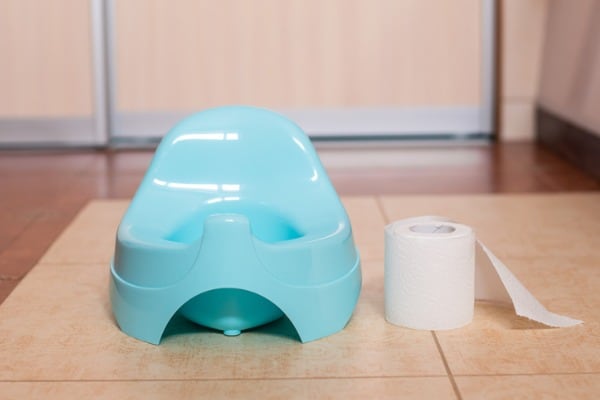
Would you be surprised that potty training and specifically what age you should potty train is a highly contested topic? Some methods say your doomed if you don’t start before age 3 and yet others insist you must wait until your child is close to 3 if not older.
Developmentally, most children are able to be potty trained at 24 months of age. But just because they turn two, doesn’t mean that they’re magically ready to be potty trained.
In fact, there’s such a wide range of ages in which children are potty trained–ranging from 21-36 months on average. We also know that statistically boys tend to pick up potty training a few months later than girls.
Beyond age, the most important deciding factor as to whether or not your little one is ready to potty train are exhibiting readiness behaviors. Things like showing an interest in the potty, able to follow simple one or two step directions, the ability to push down and pull up their own pants, among other traits are often better indicators your child is ready to be potty trained.
Learn more about my recommendations for the best potty training age to successfully potty train your little one.
Signs your child is not ready for potty training
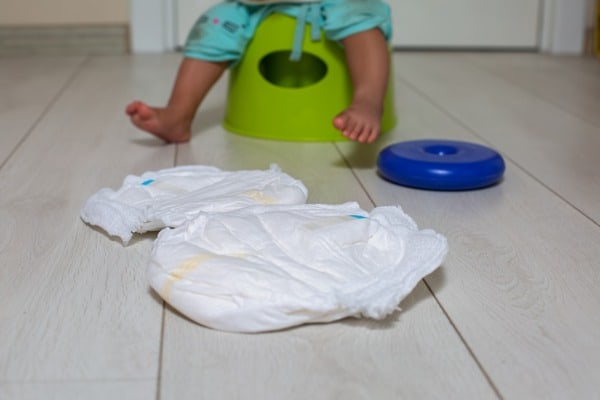
Despite the fact that you may be more than ready to give up the diapers (as a fellow parent, I can totally relate) your toddler might not. More than behavioral resistance to the whole idea of potty training, here are 4 signs your child is not ready:
They’re too young: Bladder control should be well established for potty training to be successful. This typically happens between age two and three and can easily be pinpointed when you notice your child staying dry during naps or for an hour or two during the day.
They’re not showing interest in the potty: Anyone who has ever dealt with a toddler knows–if it’s not their idea, they’re not into it. Parents are most successful potty training their kids after they’ve shown significant interest in the whole idea of using the potty.
They lack the fine motor skills to push down and pull up their pants: In order for kids to be successful at using the potty, they need a significant bit of independence. They need to be able to push down their pants and use the potty when they have to go.
They don’t follow one or two step directions: You’ll be giving your child a whole new set of instructions surrounding potty training and they need to be able to understand directions. One step directions are things like “Pick up your shoes,” and two step directions are things like “Pick up your shoes and bring them to me.”
Find more tips and helpful advice on this topic on my post, signs your child is not ready for potty training.
Potty training essentials
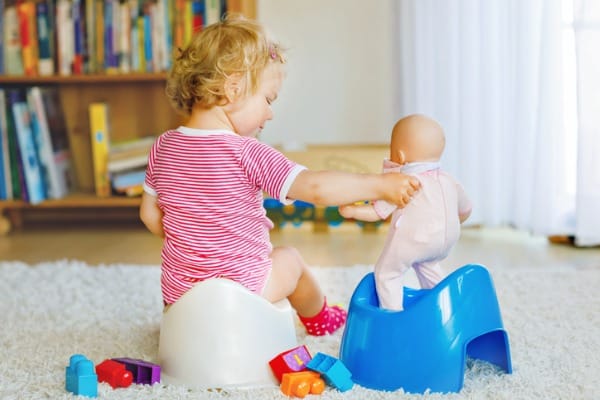
Get the process started off on the right foot by having some potty training essentials in your back pocket to ease your little one’s fears about the process.
Some kids are very interested in the potty and are roaring to go; while others need some warming up to the idea. I like the idea of introducing a potty training doll (tons of awesome items for both boys and girls) or a potty training book. There’s also a lot of potty training songs and shows, too.
Beyond books and toys designed to help toddlers get comfortable with potty training, there’s also a few items that I consider must-haves. Here’s the full list of potty training essentials that I recommend to my clients most.
Basic potty training tips
Many, many potty training resources will tell you it’s possible to potty train your toddler in just three days and while some kids pick it up that quickly, that’s certainly not the norm. Here’s a basic guide for successful potty training:
Forgo the big kid underwear at first
Forget the big kid underwear at first and potty train your little one sans pants or underwear for the first few days. The method behind this madness is simple: kids learn much quicker if they’re fully aware of what’s going on with their body. Putting on underwear reminds them of a diaper and their muscle memory just tells them to go in their underwear rather than in the potty. Keep up this strategy until they have the hang of it, which usually takes a few days to a week.
After you feel your toddler has made significant progress sans underwear, move on to pants (still no underwear at this point, as you don’t want to trigger that muscle memory). Continue watching for their potty cues and putting them on the potty when they show signs of needing to go.
Set aside a few days
Pick a long weekend or take a few days off of work to really focus on potty training. Set up the potty in a central location and watch for your child’s sign they have to go potty. Some kids hold themselves, or do a potty dance–you’ll soon pick up on your toddler’s tell. As soon as you see this happening, sit them on the potty. This is pretty much the formula for the next few days while they get the hang of everything.
Don’t set the timer
Resist the urge to set a timer every 15 minutes and have your kid sit on the potty. Instead you want to look for potty cues and sit them on the potty at that time.
Even though it seems like constant bathroom breaks will eventually lead to a success, frequent potty breaks can actually lead to “resistance reminder.”
Instead of constant breaks, it’s best to follow routine potty breaks that correspond with how one would normally use the bathroom, i.e., before nap, before you leave home, after nap, etc. Learn more about a potty training schedule here.
Want more potty training info? Here’s my guide on potty training a boy and potty training a girl.
Potty training at nap time
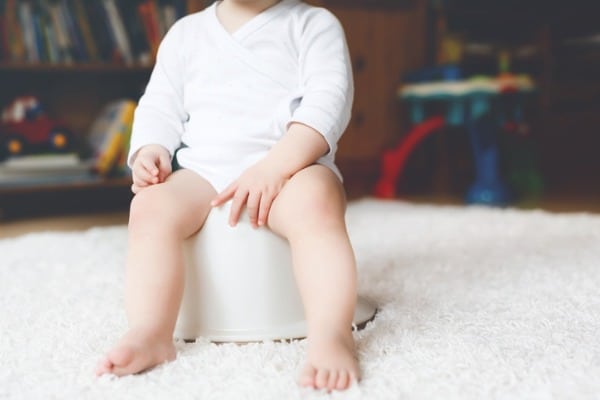
Potty training during the day seems straight forward enough, but what about potty training during naps? I have parents ask me all the time how to handle naps while learning to use the potty and my answer is never cut and dry.
First, consider the age of your child. Some parents choose to potty train their kids early, making nap time potty training a bit hard, as most kids’ bladders won’t be fully ready to hold it the entire time of a nap until they’re closer to 2.5.
Second, you’ll want to consider your overall stance on potty training. Are you more relaxed and okay with it taking as long as it does without too many interference from you? Or would you rather knock it out in less than two weeks?
I tell parents all the time that it’s totally fine to wait until you’re a couple days in to forgo the diaper at nap time. Make sure to limit liquids around nap and remember to put down a fleece blanket on their bed to sleep on so you don’t get caught changing sheets every day. It’s so easy to wash a blanket rather than all the sheets, especially if they have accidents several days in a row.
If your child is closer to 3, I’d give diaper-less naps a go, as it will only accelerate the learning curve. Remember you can leave their potty in their room and let them know they can use it if they need to. Keep an eye on nap length. They will likely not be able to hold it more than 90 minutes without an accident.
Find more nap time potty training tips here.
Potty training at night
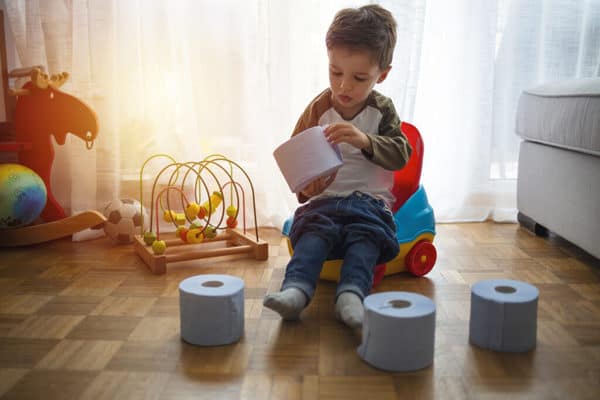
While I think potty training during naps is totally doable when you first start teaching your toddler to use the potty, I don’t typically advise potty training at night immediately.
The age range at which experts can agree that kids can hold it through the night is quite broad, with some saying it’s not until 3 or closer to 4 and yet others advising that not being able to stay dry during the night is not a problem until 5 or 6.
Sometimes, you get lucky during the potty training journey and one day your kid will just magically wake up dry. And then they’ll do it again and again. If this happens, consider yourself lucky! Get rid of the diapers and don’t look back. You should expect accidents every now and then so make sure their mattress is well protected.
Other times, a dry diaper never comes and parents start to worry, especially as their kids start to get older. In this case, you may have to actively potty train them during the night.
Learn more about how to potty train overnight here.
Potty training a stubborn 3 year old
Feel like you’ve waited too late to potty train your toddler? Don’t panic! My first child wasn’t potty trained until nearly 3 and I lived to tell the tale. Potty training a 3 year old is a little bit tricker than a 2 year old solely for the fact that older toddlers are highly opinionated and like things to be their idea.
Get your three year old on board with potty training by taking a few weeks to warm them up to the idea. Watch shows, read books, talk about it everytime you’re going, etc. Essentially, by the end of this phase you want the whole using the potty thing to be their idea.
You may have to bring in the rewards. Typically, I advise moms and dads to use a lot of praise as reward for going in the potty, but with three year olds, you may have to get creative. Find out what motivates them and offer that up as rewards. Use a reward chart and let them know they’ll be getting a reward when they complete the chart.
The biggest thing you need to keep in mind is that sometimes 3 year olds can spook easily. What I mean by that is, if you lose your cool day 2 of potty training because they’ve had more accidents than successes, they’re likely to put up resistance to using the potty after that. In those first few days and week when your child is learning, play it cool. Every they have an accident, bring them to the potty and tell them “pee goes in the potty.”
Here’s a post I wrote on how to potty train a stubborn 3 year old for more tips!
Issues with getting your toddler to poop on the potty
Many times, kids master peeing on the potty only to get hung up on pooping on the potty. There’s many reasons for this–they might be scared, they might be constipated or they might be engaged in a power struggle due to reminder resistance.
Find more tips here if your toddler won’t poop on the potty.
Have more potty training questions? Comment below so I can help you out!
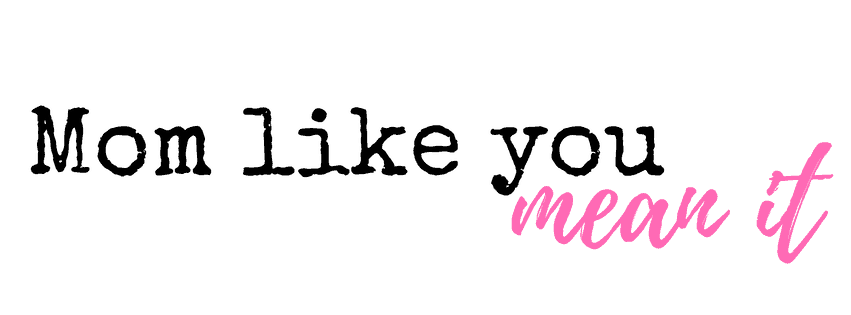
Leave a Reply